Danger of Tree Damage to Walls & Foundations – SANS 10400-H Annex-D

Cracks and damage to walls and foundations are caused primarily by soils that contract and expand due to moisture content when the soil absorbs water and swells up and then shrinks when it dries out. This puts pressure on foundations, and if not designed and built correctly will lead to walls cracking and even collapsing. Other soil types, dolomite for instance, can dissolve in water during heavy rains or when drainpipes and water pipes leak. This is why a professional geotechnical inspection is required in certain areas.
Dolomite Soils and Rainwater
Rain water takes up carbon dioxide in the atmosphere and in the soil (where the concentration of this gas may be up to 90 times greater than in the atmosphere) to form a weak carbonic acid. This weak acidic groundwater circulating along tension fractures, faults and joints in the dolomitic succession causes leaching of the carbonate minerals. The solubility of dolomite is high in comparison to other rocks, but significant solution cannot be seen over short periods (months or even years). The process of dissolution progresses slowly in this slightly acidic groundwater (above and at groundwater level). The resultant bicarbonate-rich water emerges at springs and is carried away.
Soil and Ground-Type Site Classifications
SANS 10400-H, Foudations, requires that a site inspection is done by a competent person (geotechnical) and that the site is then classified according to the following table:
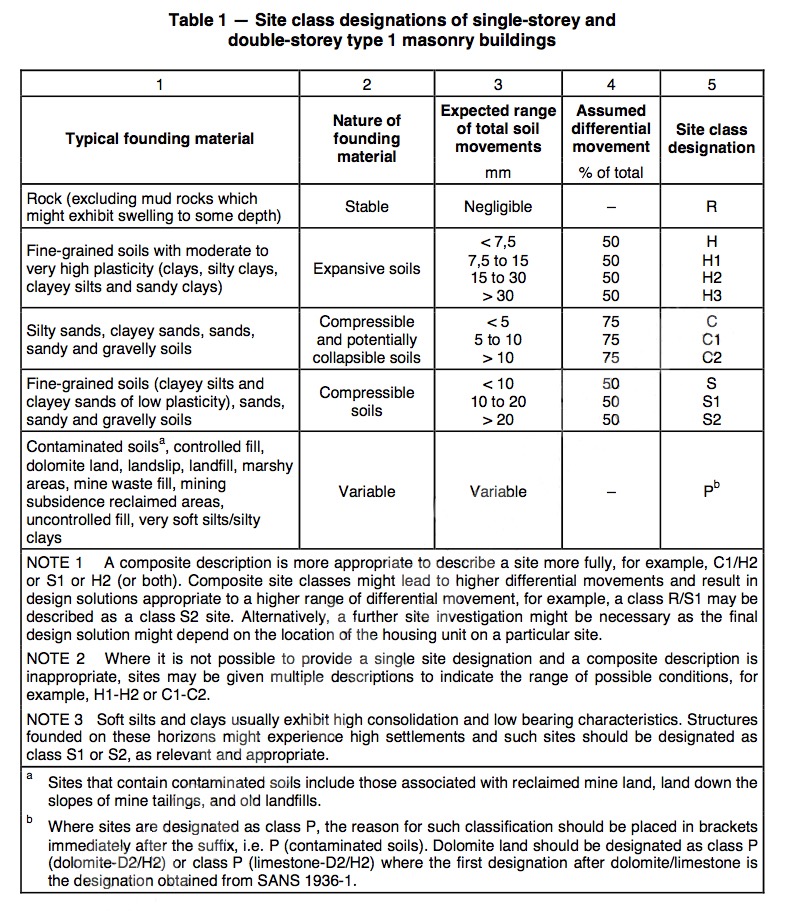
Foundation Maintenance
All soils are affected by water. Water can weaken the structure of some soils causing gradual or sudden settlements (or collapse) to take place. Expansive soils shrink or swell in response to changes in moisture content resulting in heave movements. The owner should therefore:
- Pay attention to drainage of the site. Stormwater and garden irrigation water should not be permitted to pond within 1,5 m of masonry walls.
- Ensure that shrubs are not planted too close to masonry walls. The regulations specify a minimum distance of 1,2 m on Class H sites, and 1,5 m on Class C1, H1, and S1 sites.
- Ensure that trees are not planted closer to masonry walls than the distance stated in the table below.
- Ensure the prompt repair of leaks in all plumbing and drainage.
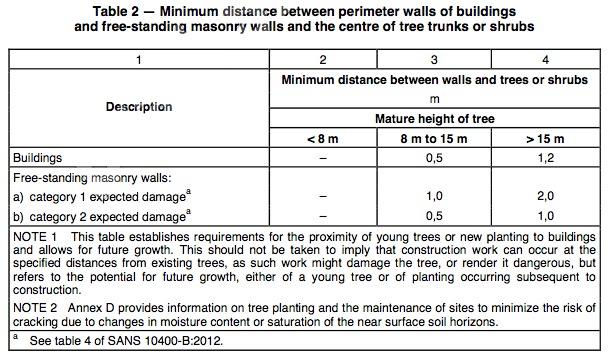
Trees That Can Cause Damage
Many structures are likely to be located in close proximity to planted or self-sown trees during their useful life. In some situations, trees can adversely affect structures and induce damage.
All trees should be regarded as a potential source of damage. The following varieties are, however, particularly prone to causing damage:
- All eucalyptus varieties
- Lombardy (Free State) poplars
- London planes
- Willows (Salix) of any type
- Jacarandas
Damage From Trees Due to Direct Action

Trees can cause direct damage by
a) the growth of roots or the base of the trunk lifting or distorting structures,
b) the disruption of underground services and pipelines,
c) the direct contact of branches with the superstructure, or
d) by being blown over.
The growth of the base of the trunk, or of roots near the surface, exerts comparatively small forces. Paving slabs or low boundary walls can be lifted or pushed aside very easily, but heavier structures or stronger structures are more likely to withstand these forces without damage.
The greatest risk of direct damage occurs close to the tree from the growth of the main trunk and roots, and diminishes rapidly with distance. The risk of damage can be minimized should precautions be taken when the distance from trees is less than that given in Table D.1 (below). New trees should not be planted closer than indicated in Table D.1. Where these distances are not observed, precautions, such as the reinforcement of foundations to resist lateral thrusts and the bridging over of roots to allow for future growth, should be adopted.
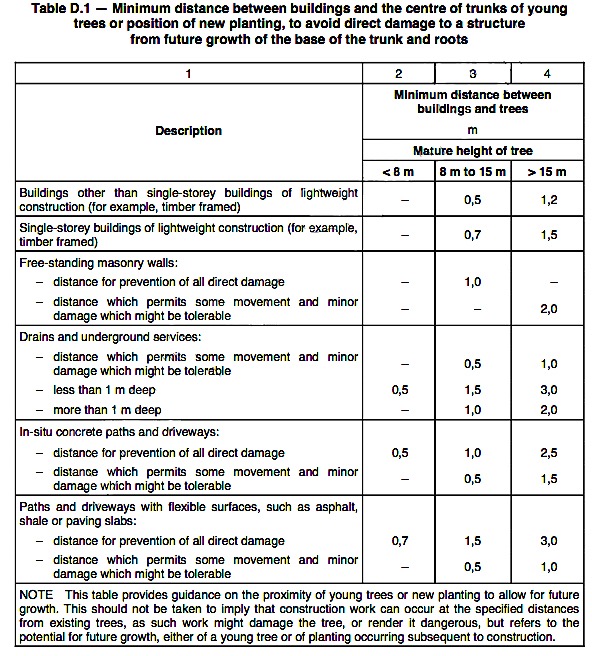
Tree Roots Can Damage Water and Drainpipes
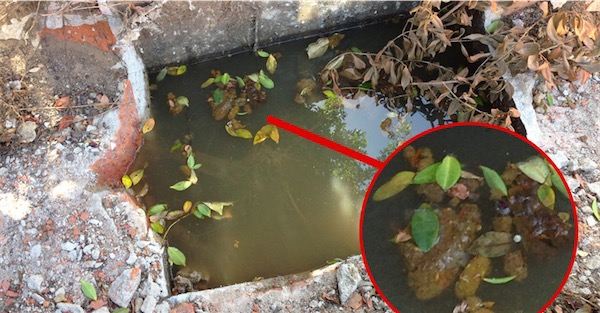
Water leaking from damaged drains, sewers or water mains will encourage localized root growth. Roots are then likely to enter a drain or sewer through the defect and proliferate, causing blockages and so aggravating the initial defect. Intact drains, provided they are further from trees than the distances stipulated in Table D.1 (above), should not suffer direct damage and will not attract roots.
Damage can be avoided:
a) by routing services in accordance with Table D.1 (above)
b) by ensuring watertight joints
c) in clay soils, with the use of flexible materials or joints (or both) to accommodate movement
Damage From Trees Due to Indirect Action
More than 99 percent of water absorbed by trees is transpired through its leaves into the atmosphere. This causes the soil to dry out and, in the case of clay soils, to shrink. Any subsequent wetting up of the clay will induce swelling. In this manner trees and large shrubs can induce movement on clay founding horizons resulting in damage to structures. The severity of movements so induced depends on the percentage of clay content and the mineralogy of the clay, the depth and extent of the root system of a tree and the efficiency of a particular type of tree to extract moisture from the soil.
To avoid damage caused by these movements, it might be necessary to adopt one or more of the following actions:
- Ensure that design structures tolerate soil movements associated with trees
- Ensure that foundation structures are on a horizon below the level of moisture content
- Remove the offending trees and shrubs
- Provide a moisture barrier as shown in Figure D.1 (below) so that roots cannot pass through, below or around them
- By siting structures or planting large trees and shrubs no closer than the dstnces shown in Figure D.2 below
1) H1 sites: 0,75 × mature height
2) H2 sites: 1,0 × mature height
3) H3 sites: 1,5 × mature height
The effects of the removal of trees on clay sites should also be considered. It is important to realize that removal might induce large swelling movements as soil profiles wet up, particularly where trees have depressed the water table over a period of time.
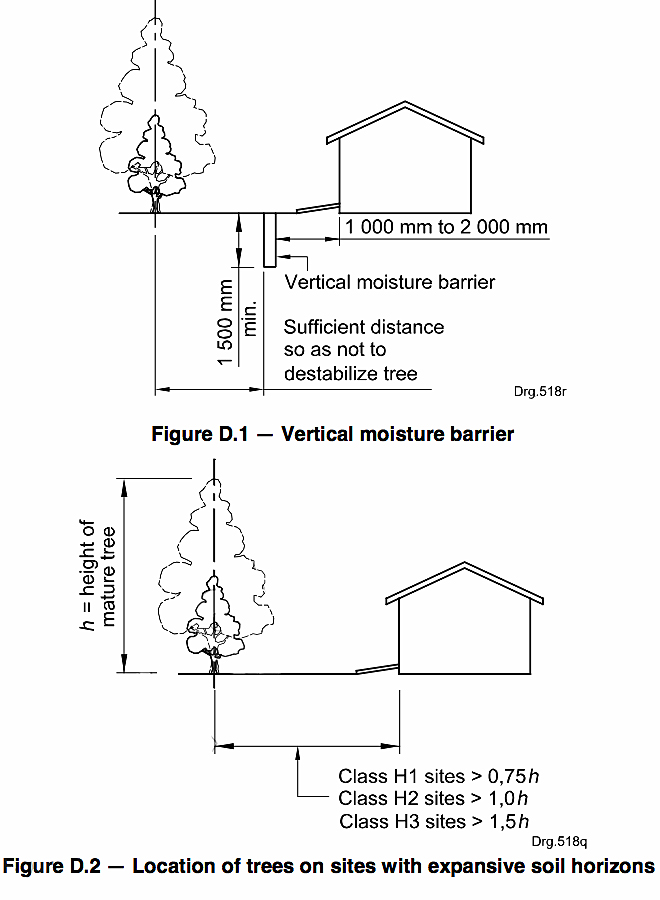
Here are a couple more pictures showing problems:
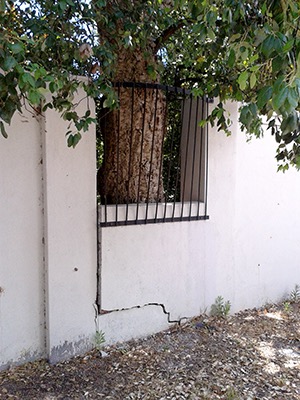
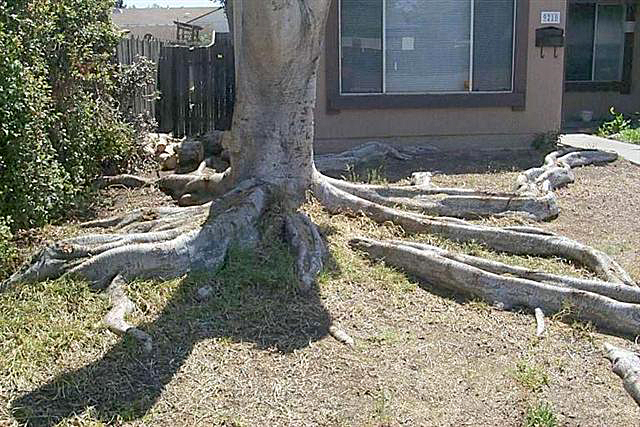
 SANS10400-Building Regulations South Africa SANS10400 are the Building regulations in South Africa, and both international and national standards, are fundamental to successful building and construction projects, both big and small.
SANS10400-Building Regulations South Africa SANS10400 are the Building regulations in South Africa, and both international and national standards, are fundamental to successful building and construction projects, both big and small.

This tree should be added to the list
Caesalpinia ferrea
(Leopard Tree)
Caesalpinia ferrea, the beautiful leopard tree, may seem to be an African tree, but it actually originates from Brazil. You’ll find this delicate tree already showing lots of character as it stands with its pale, upright trunk in a 20-litre nursery bag. The rust-brown new leaves at the growth points of its many branches, and the mid-green,compound oval leaves further along the branches are attractive and delicate and it is plain to see that this tree is not going to provide deep shade. (This also means that you won’t need to go searching for deep shade plants that battle to grow amongst tree roots.) The smooth bark exfoliates easily but incompletely, often leaving large dark brown patches against a light background – the reason for the common name.
If you are in a nursery somewhere in Johannesburg or Cape Town, they might say that this is a slender tree with an unusual trunk, and that it is ideal for small gardens. This is because in moderate climates that experience light frost or dry summer climates, the leopard tree is not a giant – Mother Nature stunts its growth. But be warned, if you plant it in Durban or the Lowveld, (its natural habitat is similar to our humid subtropics) the leopard tree grows to 15 m tall with an aggressive root system that mirrors the size of the tree above the ground.
Caesalpinia ferrea should rather not be planted close to structures, underground cables, drains and water pipes. But if you have lost your heart to the exotic tree, do plant one or more in your garden, or even in large pots in your courtyard.
When do they bloom?
Tiny, golden yellow, bell-shaped flowers appear in spring, followed by dark seed pods.
Most suitable climate
Moderate and subtropical regions are its favourite. It is frost-sensitive and doesn’t like windy conditions.
What they need
Location: full sun or light shade. A few planted together make a pretty mini-forest in an expansive lawn, or with ground covers planted between them.
Soil: well-drained sandy soil.
Water: regular watering for saplings, less water for mature trees. Medium water consumption.
Fertilizer: compost.
In a nutshell
* Slender deciduous tree providing light summer shade.
* Attractive, colourful trunk.
* Lovely in a mini-forest.
* Ideal tree for a tropical-style garden
Posted by: Administrator – Tue, Apr 23, 2013 at 2:27 PM This article has been viewed 12732 times.
Filed Under: CC, Trees for large gardens
Avacado tree and about 15m height is 12m away from the house.I would like to ask how much the damage its will cause in more years to come.
“Ensure the prompt repair of leaks in all plumbing and drainage.” How do you know if your sewerage plumbing system which is under ground is leaking? Also in the last devastating photo the tree looks to be more than 1.5 meters from the house which is correct according to the above table.
Hi Jacques, Yes that is a tough one to monitor but in my experience once the outlet pipes start to leak then roots get in and block the outflow, see the story here: http://sans10400.co.za/blocked-drains/ This had multi problems a squashed pipe and roots growing into pipes. In answer to the tree that is more than 1.5m away the regulations do say that you must choose a tree variety that does not have shallow spreading roots.
Hi Zipho, I am not a tree expert so I can’t give you advice on this. I suggest go to your local plant nursery and ask an expert there.
Thank you Mike for the addition, much appreciated 😀
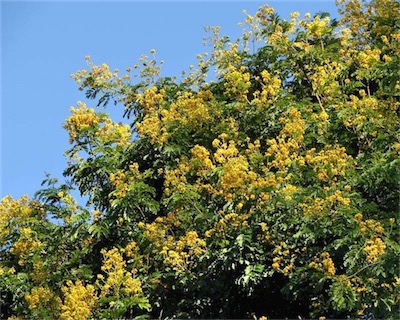
All Ficus species should be banned from urban areas. All too often a beautiful potplant of the genus is planted in the garden, unknowing what damage it will cause within a few years.
I did not receive a soil test certificate for white ants from the developer of the estate that I live in.Now I have white ants that are eating away my furniture and fittings.DO I have recourse.
Hi Janek
Please help: During the wind storms in KZN last week, the neighbours’ avocado tree fell over the property wall, collapsing a 10 metre section of the wall. Who is liable for the repairs? The neighbours are unresponsive, they only removed the tree, the bricks are still scattered on our property. We both have dogs who are not very friendly to each other and there might be a nasty incident involving the dogs. Also, it is unsightly.
Hi. We had five White Stinkwood trees on our property. The one in our front yard was planted about 10m from the house in the early seventies. It was the oldest tree of the five. As we entered into the 2000’s we started having problems related to the roots lifting oud concrete path over time. The promblems seem to escalate. In 2016 we discovered to our horror how close the roots were growing toward our house. We decided to have all five as they were of similar distance from other structures. The tree is recommended for medium gardens and larger.
The diameter of the tree top was about 20m in diameter when it was cut down.
My advice is for anyone wishing to have such a lovely tree in the garden is to plant it more than 20m away from any structure or known underground infrastructure.
It was sad to cut down the tree, but it had to be done.
We have White stinkwoods belonging to the council lining the pavement.
I believe that so far as the branches of a tree spread laterally away from the trunk of the tree potentially the roots will spread an equal distance from the tree.
My neighbor has three trees that is breaking the precast wall apart and wall is broken on three places. The trees also mess with my electric fence and the neighbor just says he has no money but the house is in the market and I feel like you wants to get rid of the problem. I have young kids and he has dangerous dogs. What do I do? Benoni
On a residential property, who is responsible for which boundary wall, or are both parties responsible for the boundary wall they share?
I want to know if I build next to the boundary in Cosmo city ext 9 what should I do I have got a letter from municipality said I must submit the plans within 30
My question is not related to walls. Could somebody tell me if a palm tree is prone to be struck by lightning. The palm tree is about 1 meter from the boundary wall and there is a open shade netting cover resting on this boundary wall on the neighbors property.
Hi. Our neighbor cut down our hedge without permission or discussion. It was not impacting on the boundary wall. The cuttings were left in our yard and he refuses to clean. We now sit with a security issue as well. What are our rights? Law enforcement says they can’t assist and so do the police. Neighbor claims boundary wall is his but no proof of such.
Hi
A self-seeded Witstinkhout tree has grown up next to the boundary wall between my and my neighbour (on my side). The tree has now reached about 10 meters in height, but the tree roots have cracked and shifted the boundary wall. I am willing to pay for the cost of repairing and shifting the pre-fab concrete wall to make a u-shape around the tree, but my neighbour says no, we will need approved plans to do that. It only involves two upright panels, and those two panels will be inside my neighbour’s erf (only protruding half a metre into their yard).
Any suggestions? Other than cutting down this magnificent tree – it has a beautiful shape and provides a lot of shade as well as being a big favourite with the birds.
Please help?
Is it advisable for a spruce type tree of about 6 m tall to stand on the edge of a retaining wall.?
Ask a landscaper or plant expert. The building regulations do not specify or rule on planting. But in my personal opinion – NO!
Sorry to have taken so long to respond. I hope you found a solution. Doubt your neighbour would have needed approved plans for his wall, unless it was a high one. Anything less than 1,8 m doesn’t need plans.
No more than any other trees!
It depends who built it!
Take legal action if you can afford to! Or hope he moves soon!
I hope the problem is now solved!